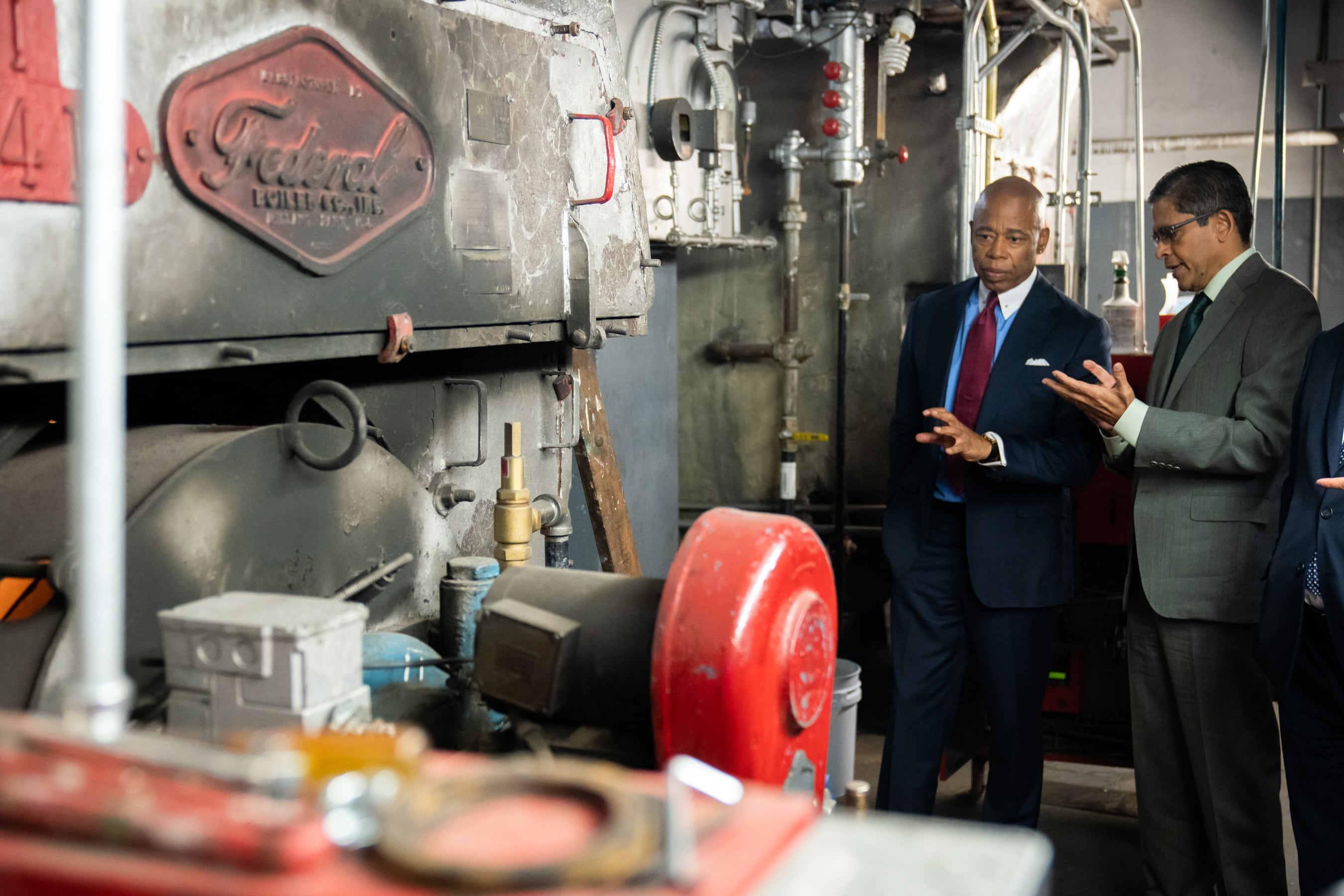New York City will commit billions of dollars to convert 100 fuel-burning public school buildings to cleaner energy by 2030 as part of an effort to comply with emissions reductions mandated by city law, Mayor Eric Adams announced Friday.
The city will spend roughly $4 billion over the next seven years on a plan that includes retrofitting 100 school buildings so they no longer burn fossil fuels for heating. That shift will help bring the city closer to compliance with Local Law 97, which sets limits on greenhouse gas emissions that buildings must adhere to starting in 2024.
Adams also announced that every new school building, including those already under construction, will be fully electric, putting the city slightly ahead of schedule on a separate 2021 city law that effectively bans gas in new construction starting in 2024. Newly constructed public school buildings must be fossil fuel-free beginning in 2025 under that law.
“Every New York City school we build going forward will be fully electric,” Adams said Friday at a press conference in P.S. 5 in Bedford-Stuyvesant, which will be the first to get retrofitted under the new plan. “No more boilers, no more burning dirty fuel, no more contributing to asthma.”
The 100 existing schools that will get their boilers removed and heating systems revamped are all located in neighborhoods with high levels of asthma, Adams said. Pollutants released in the burning of heating fuels can contribute to health conditions including asthma, which disproportionately affect Black and Latino children in New York City.
“I was just downstairs in the basement,” Adams told the elementary schoolers assembled at Friday’s announcement. “The boiler is loud, it burns fossil fuel, which causes a bad environment. We’re going to replace that system.”
The city’s aging public school buildings, which still largely rely on oil and gas for heating, are a major source of air pollution and greenhouse gas emissions, spewing out the equivalent of 154,000 cars’ worth of carbon dioxide emissions every year.
The sweeping city law passed in 2019 requires large city buildings – both public and private – to reduce their greenhouse gas emissions in an effort to cut overall building emissions 40% by 2030 and 80% by 2050.
City officials said the plan rolled out on Friday will go a long way toward meeting that goal, reducing greenhouse gas emissions by an estimated 120,000 tons a year - the equivalent of taking 26,000 cars off the roads.
The city Department of Education already reduced emissions by 14% across more than 800 buildings between 2014 and 2019, according to a recent report from the Center for an Urban Future.
The city’s new initiative, dubbed “Leading the Charge,” will also include a $540 million effort to install more efficient LED lighting across 800 schools, and will help halt the use of No. 4 oil - a particularly polluting variety - by 2026, according to city officials. No. 4 oil is supposed to be phased out of most buildings by 2030 under city law, and legislators were recently considering a bill that would move up the deadline to 2025.
The clean energy initiatives will cost an estimated $4 billion by 2030. The city has already “committed” $2 billion and will have to “identify the remaining funds in the coming years,” officials said. It was unclear if any of the funding comes from federal COVID relief stimulus money.
Clean energy advocates have pointed out that while the upfront costs are high, retrofitting can also help save money in the long run by cutting fuel costs. The city didn’t immediately provide an estimate of how much money the initiative will save.
Robert Troeller, president of Local 891 of the International Union of Operating Engineers, which represents custodian engineers, said he hadn’t yet heard about the specifics of the new plan, but that “it’s certainly a good general direction for the city and state.”
Troeller added his one concern was for any “people who lose jobs because of this.”
City officials said the initiative will create new jobs for “union electricians, plumbers, steamfitters, and machinists,” who will help shift schools away from No. 4 oil, but didn’t provide an estimate of how many new jobs.
The education department is also looking into expanding career and technical education offerings to train students interested in working on building and maintaining the new all-electric systems.
Samanatha Maldonado, from THE CITY, contributed. This story is a collaboration between Chalkbeat and THE CITY.
Michael Elsen-Rooney is a reporter for Chalkbeat New York, covering NYC public schools. Contact Michael at melsen-rooney@chalkbeat.org.






